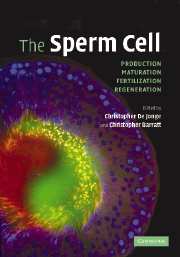Book contents
- Frontmatter
- Contents
- Preface
- List of contributors
- 1 Mammalian spermatogenesis and sperm structure: anatomical and compartmental analysis
- 2 Sperm chromatin stability and susceptibility to damage in relation to its structure
- 3 Genomic and proteomic approaches to defining sperm production and function
- 4 Sperm maturation in the human epididymis
- 5 Controls of sperm motility
- 6 Regulation of capacitation
- 7 Reactive oxygen species: friend or foe
- 8 Testing sperm manufacturing quality: the sperm–zona binding assay
- 9 Genetics: a basic science perspective
- 10 Sex chromosome abnormalities and male infertility: a clinical perspective
- 11 Epigenetic patterning in male germ cells: importance of DNA methylation to progeny outcome
- 12 The DAZ gene family and human germ cell development from embryonic stem cells
- Index
5 - Controls of sperm motility
Published online by Cambridge University Press: 14 August 2009
- Frontmatter
- Contents
- Preface
- List of contributors
- 1 Mammalian spermatogenesis and sperm structure: anatomical and compartmental analysis
- 2 Sperm chromatin stability and susceptibility to damage in relation to its structure
- 3 Genomic and proteomic approaches to defining sperm production and function
- 4 Sperm maturation in the human epididymis
- 5 Controls of sperm motility
- 6 Regulation of capacitation
- 7 Reactive oxygen species: friend or foe
- 8 Testing sperm manufacturing quality: the sperm–zona binding assay
- 9 Genetics: a basic science perspective
- 10 Sex chromosome abnormalities and male infertility: a clinical perspective
- 11 Epigenetic patterning in male germ cells: importance of DNA methylation to progeny outcome
- 12 The DAZ gene family and human germ cell development from embryonic stem cells
- Index
Summary
Introduction
Spermatozoa must be motile for their journey to the egg. In species that undergo external fertilization, such as sea urchins and fishes, the initiation of sperm motility occurs at spawning and movement is further regulated by factors released by oocytes. In mammals, the swimming ability is progressively acquired by spermatozoa during the epididymal transit even though motility is initiated only after dilution in seminal plasma. Factors from the female genital tract will later on trigger the hyperactivated motility that is needed for sperm penetration of the zona pellucida.
In this review, we will first examine the structure of the flagellum giving a special attention to the axonemal motility apparatus. Then, we will briefly discuss some of the factors that influence the initiation, maintenance and evolution of sperm motility.
Experimental approaches to study sperm movement
Before describing the flagellum, we will briefly mention some technical aspects of motility measurements and the most important experimental approaches or models that are used to evaluate the role, and mode of action, of specific structures in flagellar motility.
High speed videomicrography is an essential tool for the measurement of parameters such as the percentage of moving cells, the flagellar beat frequency (the number of complete beats per second; by stroboscopic illumination), the surface of flagellar beat envelope (surface covered by the flagellum over a complete beat) and the maximal wave amplitude (width of the beating envelope) (Brokaw and Kamiya, 1987; Cosson et al., 1999; Gingras et al., 1998).
- Type
- Chapter
- Information
- The Sperm CellProduction, Maturation, Fertilization, Regeneration, pp. 108 - 133Publisher: Cambridge University PressPrint publication year: 2006
- 10
- Cited by



